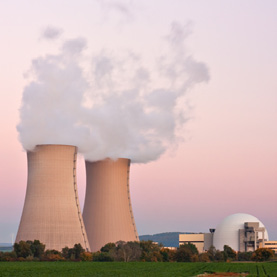Improved safety in pressure vessel walls of nuclear power plants
Around 200 nuclear reactors are currently in operation in the European Union, and many countries will, in the future, continue to view nuclear energy as a central energy supplier. In order to ensure maximum safety, the lifetime of the reactor components must be calculated reliably. As part of the ten-partner EU research project NOMAD, Fraunhofer IZFP in Saarbrücken is leading the challenge to find methods for characterizing material changes in reactor pressure vessel steels in a focused and timely manner.
The reactor pressure vessel protects the outside world from radiation from the fuel elements. Over the long term, however, this radiation can lead to vessel wall embrittlement. Sudden failure of a reactor pressure vessel due to embrittlement would be disastrous for humanity and our environment. Until now, safety routines have been based on monitoring concepts in which small samples are already taken during the manufacture of the reactor pressure vessels, placed inside the vessel and intermittentlyextracted for destructive tests. “However, the material of a reactor pressure vessel is not always homogeneous; thus, such samples cannot be always considered a solid reference for the entire pressure vessel,” explains Dr. Madalina Rabung of Fraunhofer IZFP, coordinator of the NOMAD project. Here, solutions are being developed that can be used to carry out regular, non-invasive inspections of the complete reactor pressure vessel wall using intelligent sensors based on electrical, ultrasonic, acoustic and micromagnetic techniques. These are important steps towards even safer operation of nuclear power plants.
This project has received funding from the Euratom research and training programme 2014-2018 under grant agreement No. 755330.
Last modified:

